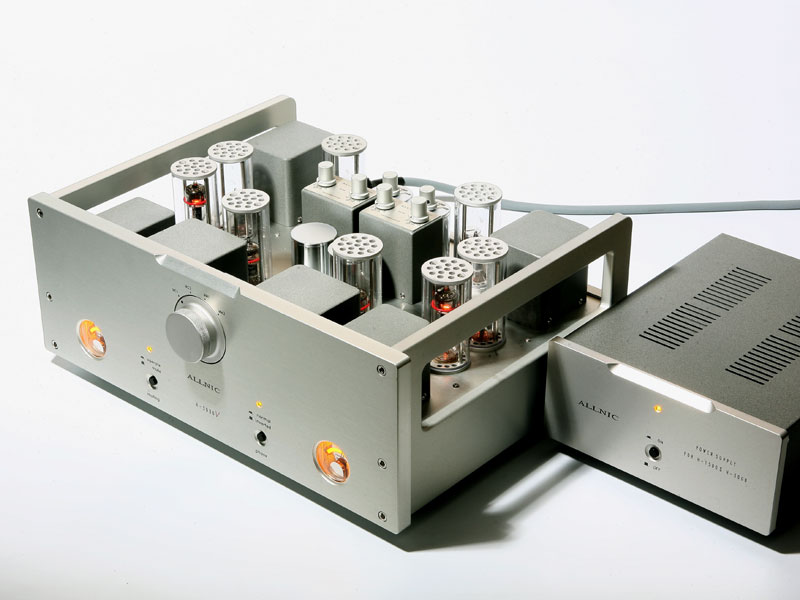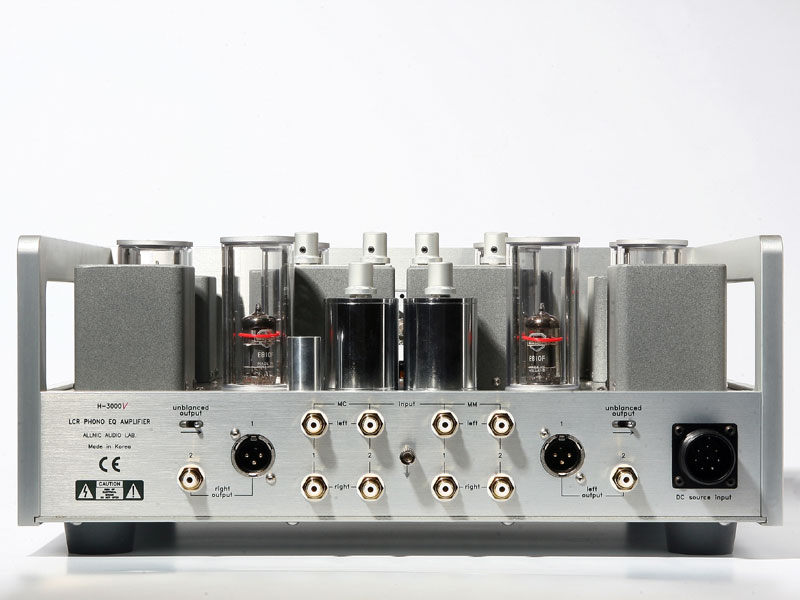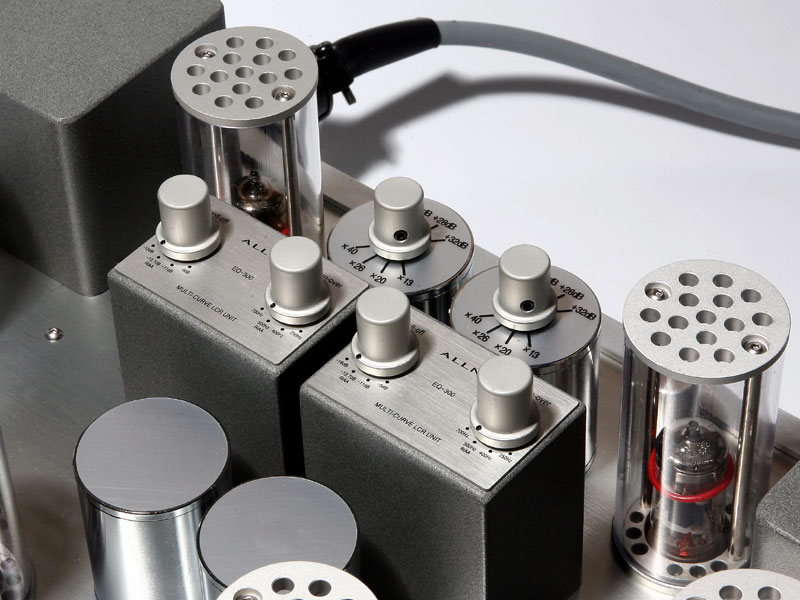Positive Discrimination: Righting EQ Wrongs With the Allnic H-3000V
I’ll be the first to hold up my hand and declare, "Guilty as charged." Although I was aware of the name, that was pretty much all I was aware of. It was not until Marc Mickelson, following our phono-equalization demonstrations at the Rocky Mountain Audio Fest last year, arranged the loan of the company’s top phono stage, the H-3000V ($13,900), along with the Puritas cartridge ($4950), that I got some hands-on experience. Believe me, it was much more of an experience than I was expecting -- and it started with opening the box.
I really wasn’t prepared for the beautifully crafted and immaculately finished main chassis of the H-3000V. The tube chimneys that both protect and cool the eight twin triodes nestle in amongst no fewer than thirteen other potted components on the crowded top deck. The substantial handles running along each side are far more than simply cosmetic, while the form and function is simultaneously cleanly focused and respectfully retro. The thick front panel is substantial without being overdone, carrying switching for four separate inputs (two MM, two MC) phase, mute and two circular, illuminated meters that indicate tube status/condition and simply add to the attractively traditional appearance. The rear panel is clearly laid out, with well-spaced sockets and a choice of balanced or single-ended outputs, while a gaggle of rotary switches on the top of the chassis allow you to set gain, cartridge loading and record-replay EQ. The separate power supply is a smaller unit that sports an equally elegant front panel and a usefully long umbilical, allowing you to site it a sensible distance away from the critical audio circuits. If you want proof of just how obsessive Allnic are about every aspect of their components, look no further than the massive but superbly precise multi-pin connector that links the two boxes together. No fumbling here: the machined metal body slides home with a nice, positive motion, the screw collar engaging perfectly. Any number of cheaper solutions would have worked -- but they wouldn’t carry that same sense of quality and security, a feeling that informs every aspect of the H-3000V, from its rotary input selector to the sturdy solidity of the units as a whole.
It’s hard to do justice to just how nicely proportioned and finished the Allnic is. The available photographs really don’t do it justice, and it’s not until you get to see it in the flesh and run your hands over its smoothly solid form that you appreciate the care that’s clearly gone into it. In a world where too many manufacturers of tube equipment seem to feel that they have a special dispensation to produce products that look like they were put together in a garden shed, the Allnic range puts most of the competition to shame, living proof that retro looks don’t have to mean shoddy construction. And have no doubts that the same care extends to the insides as well. Sometimes you can judge a book by its cover
n many ways, the H-3000V is an archetypically Bauhaus product. You can tell an awful lot about it just from the way it looks. All those potted blocks on the chassis should tell you that this is a transformer-coupled -- input and output -- dual-mono design. The switching options tell you that it’s adjustable for all the usual parameters and a few more besides. It’s also a fully balanced device (although it doesn’t offer a balanced input). Marc has described the circuitry in detail in his own review of the H-3000, including the unusual use of an LCR network for record replay equalization, with its claimed benefits of low loss, high speed and improved bass performance. He also wrote a follow-up blog on the subject of the H-3000V and HA-3000 head amp. So why the extra words from yours truly? Partly because the variable-EQ aspect of the design got slightly swept aside by the benefits available from the addition of the HA-3000 in place of the H-3000V’s MC input transformers -- and partly because this is a genuinely exceptional product that’s certainly worthy of the extra attention. The difference between the H-3000 and the H-3000V lies in the ability to vary the record replay equalization -- that and the $2000 you’ll pay for the pleasure. That might seem like a lot of money, especially if you are one of those listeners who chooses to believe that all the record companies magically switched to RIAA equalization at the swish of a pen. Sadly, the all-too-audible evidence to the contrary is hard to ignore -- unless you simply refuse to listen to it. Take Deutsche Grammophon Gesellschaft (DGG) as an example; as long as they produced vinyl, they never adopted RIAA. Just arm yourself with a bunch of pressings, ranging from early tulip labels right through to the latest you can find, and you’ll soon discover that switching the replay EQ transforms the artistic merit of the performances, as well as the pleasure to be had from listening to them. And it’s not just DGG. Decca, EMI and Columbia (to name a few) all deviated from the RIAA standard -- in many cases for years after the RIAA concord had been signed in 1958. In fact, compliance levels were so low that the RIAA even sent out a reminder letter to all signatories in 1964 -- and how many do you think took any notice? This is not the place to debate the whys and wherefores of history; instead I’d rather just note that the Allnic H-3000V offers the facility, look at its operation and then describe what it does -- and who it does it for.
The "V" suffix adds a pair of small rotary controls to each channel of the phono stage, perched on potted blocks towards the rear of the chassis and just in front of the gain controls. These offer four discrete values for roll-off and four more for turnover, giving sixteen possible settings. It’s a manual arrangement that cannot compare for convenience with the five settings on a single switch offered by the Zanden phono stage, or the three settings switchable by remote control you get with the Audio Research Reference Phono 2. This brings us to the nub of the problem when it comes to replay equalization. Although there were a great many curves in use, each unique to its user, many of them were very similar to one another and can be successfully grouped into families, allowing a "one size fits all" solution. The Allnic approach offers a wider range of options, with far more precise matching of curves, but you will find yourself using the same four or five settings more often than not. The manual nature of the operation doesn’t particularly worry me (if it did I’d have given up on records a long time ago), but, on a practical note, the position of the switches does demand clear access to the top of the unit, so you’ll really need to allow a top-shelf position for it -- or a lot of space above it. Who needs it -- and why
ho needs this facility? It’s almost easier to list who doesn’t. If you listen to an exclusive diet of late, US-pressed pop music, you can probably live without it. If you only play 180-gram audiophile repressings, you can definitely live without it. If you have a small record collection and you only dip into it occasionally, don’t bother about replay EQ -- there are better ways to spend your money. If, on the other hand, you own a lot of records and that collection embraces classical and jazz; if you own a mixture of US and European/English pressings (irrespective of genre); if you already own a mono cartridge; if you are a collector of vintage vinyl or you have a fascination with Decca, von Karajan or any number of early jazz artists; if you come close to any of those descriptions, then a phono stage with variable EQ will be a revelation. When we demonstrated the musical impact of switchable replay equalization at the RMAF, we did so using the following discs (amongst others): Dvorak: New World Symphony [DGG SLPM 138 922],
1964 In each and every case, the results were clearly audible and musically significant -- even dramatic. And yes, you did read that right. Early US pressings of Kind of Blue were not RIAA -- or if they were they got it badly wrong. How long that situation persisted I have no idea, but the chances are that many of us have never heard what is arguably the most popular jazz recording of all time replayed with the proper EQ curve (we’ll leave pitch out of it for now). You can argue about which is right or wrong, more or less accurate until the cows come home, but the bottom line is simple: in a great many cases switchable EQ makes records sound substantially better and more real -- and the results are consistent enough with label to suggest that this is more than simple tonal aberration from one disc to another. Decca, DGG, EMI and Columbia: together that’s a fair proportion of my record collection, and if I can significantly improve the rewards of playing those discs, you’d better believe I’m going to. Biting the bullet
o, time to look at a few examples, and where better to start than the "New World" recording that we played at RMAF -- not least because some of you will have actually heard it. Replay this disc (an early tulip-label pressing) on the clearly marked RIAA settings -- 500Hz turnover and -13.7dB roll-off -- and you’ll hear what will be for many of you the familiar wash of turgid, indistinct and disjointed sound that characterizes DGG records, all thick bass and screechy highs. You don’t need to listen much further than the opening bars, the heavy, slow tempo and ponderous playing wash the music ashore with all the life and energy of BP’s oil slicks heaving against the beach in the Gulf. A couple of minutes are all it will take to confirm your opinion of DGG -- and von Karajan too. Now, switch the turnover to 250Hz (two notches) and the roll-off to -11dB (one notch) and listen again. As soon as the music starts you’ll be aware of both a coherent soundstage and a sense of instrumental focus and delicacy. Not only are the various instruments clearly identified and placed, but their contributions -- what they play and when -- suddenly start to make sense, building a musical whole, a musical whole that’s actually compelling and dramatic. The sudden dynamic shifts are explosive, driven not just by the superb definition and weight of bowed bass and drums (an Allnic specialty) but by the perfect one-two timing of their playing. This isn’t just a new performance, it’s like a whole new record of a completely different orchestra. It has moved from unlistenable to really interesting and worthwhile. Not only can you begin to appreciate why the Berliner Philharmoniker enjoys a stellar reputation, you can actually understand both von Karajan’s status and his enduring relationship with the orchestra. You might wish for a more romantic reading, but that’s a question of taste -- and at least now you are in a position to make that judgment. As it is, the impeccable ensemble playing and absolute authority of the performance are immediately and impressively apparent. What about a later pressing? How about Karl Bohm conducting the Vienna Philharmonic in Mozart’s Symphony No. 41 [DGG 2530 780]? This 1977 recording was actually pressed in the UK, yet still the gulf in performance persists. Stolid, harsh and ponderous replayed on the RIAA curve; switch to the preferred settings for DGG and the music takes on the vivacious, lively and energetic character so central to Mozart. Perhaps the most interesting change is that the orchestra sounds smaller (in numbers) but has greater power and impact, making for a far more dramatic presentation of this boldest and most powerful of all Mozart’s symphonies.
Other examples are legion; a quick run through the Decca back catalogue? Let’s start with La Fille Mal Gardee [Decca SXL 2313], recorded in 1962, again on the basis of familiarity. Comparing a curve of 700Hz/-11dB to the RIAA standard produces a pretty dramatic improvement. Not only is the soundstage far more apparent and coherent, the tonality, instrumental balance and texture all improve. The instrumental tuttis are far more sudden with much greater dynamic range and impact. The RIAA setting sounds soft, veiled and purposeless in comparison, with none of the sprightly character that makes this disc such an enduring favorite. Turning to the Kyung-Wha Chung Sibelius Violin Concerto [Decca SXL 6493], recorded in 1970, you’ll hear identical results. It might not be quite as good a recording, but it still sounds a whole lot better with the correct EQ, removing a thickness from the solo instrument and congestion from the soundstage, restoring the orchestral balance and bringing a sense of timing and poise to the performance. So much for the full-price pressings. What about the budget labels? Kubelik’s Brahms 2, originally recorded in 1958 and rereleased on Ace of Diamonds in 1965 [Deccca SDD 118], exhibits exactly the same benefits, the EQ switch again restoring spatial coherence, orchestral balance, pace, poise and timing. The even later Eclipse pressings are the same again. So far I’ve listed only classical recordings and I haven’t even touched EMI, but I’m guessing that you’ve got the message by now. Dennis Davis, equipped as he is with an Audio Research Reference 2, could give you an exhaustive list of examples from amongst his extensive collection of jazz titles, and the same is true of pop. It’s just that the sheer variety of material and labels makes any sort of general conclusions difficult. The RMAF demonstration fastened on Apple, but there are plenty of other options. So if you see yourself buying original UK pressings of the Beatles, the Stones or Pink Floyd, to mention just a few, then replay EQ is going to be an issue. Nor are these results system dependent. In the course of this listening I employed the Lyra Titan i, the Clearaudio Goldfinger Statement and Allnic Puritas, all with completely consistent results. Get into mono microgroove records and the Dorian Mono cartridge and the facility becomes even more important, with far wider record-to-record variation. In short, if you are serious about playing records, variable EQ should be on your agenda. Once you’ve lived with what it does, you’ll find it awfully hard to go without. Spoiling the ship?
ne huge issue with adjustable replay equalization is whether or not it compromises the overall performance of the phono stage. It’s a legitimate concern, given the fragility of the signals involved and the difficulty of building a really great phono stage in the first place. Like most things in hi-fi, incorporating variable EQ is fine as long as you do it right. The other units I’ve referred to here (from Zanden and ARC) are both near the top of my own personal list of great phono stages. The Allnic H-3000V is the latest addition to that list. Just for fun (and by way of reassurance), I compared the Allnic to the Connoisseur 4.2, about as straight-line a unit as you can get: one set of inputs, one set of outputs, fixed gain and loading. The Lyra unit is remarkable for the clarity of purpose, presence and energy it brings to record replay -- qualities that almost (but not quite) enable it to sidestep the issue of replay EQ. It might be RIAA only, but it still gets more musical coherence, drive and sheer get-up-and-go into most performances than the competition. The Allnic might not match it for immediacy and presence, but it’s not far behind. It also throws astonishingly coherent soundstages, with superb instrumental focus and separation, all underpinned by the most clearly defined, naturally weighted and beautifully textured bass I’ve ever heard off vinyl. Marc was right to laud this unit. In its "V" version -- and even without the HA-3000 up front -- the Allnic is one stellar phono stage. With superb build quality and styling (well, I love it
anyway) and sonic qualities to match, this phono stage forces its way into direct
contention with the very best units there are. It's versatile, utterly fuss-free and a joy
to use. How many phono stages does one man need? If it’s the Allnic H-3000V, then the
answer is only one. I suspect it’s all the phono stage you’ll ever need. |




 And that’s the key point to
underline again and again. This is not just about tonal variation; it’s about the
character and intelligibility of the music, the performance and the performers. Correcting
replay EQ doesn’t just tweak what you hear; it can totally transform it. I’ve
chosen two examples from Deutche Grammophon because the results are totally consistent,
irrespective of the age of the pressing. I have never found a DGG record that conformed to
the RIAA standard.
And that’s the key point to
underline again and again. This is not just about tonal variation; it’s about the
character and intelligibility of the music, the performance and the performers. Correcting
replay EQ doesn’t just tweak what you hear; it can totally transform it. I’ve
chosen two examples from Deutche Grammophon because the results are totally consistent,
irrespective of the age of the pressing. I have never found a DGG record that conformed to
the RIAA standard.